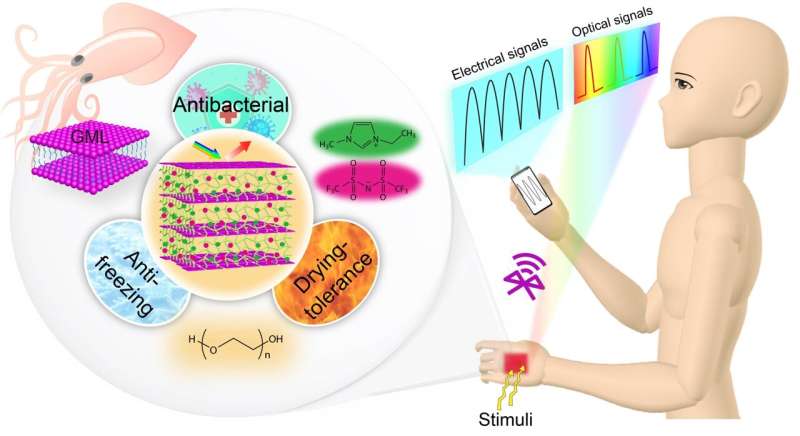A squid-inspired artificial skin that endures harsh environments
Countless hardware and software solutions created over the past decades draw inspiration from animals and natural phenomena. This includes electronic skins (e-skins), flexible and stretchable electronic circuits designed to replicate the human sense of touch or accurately detect the tactile properties of objects.
Researchers at Dalian University of Technology in China recently created a new artificial skin inspired by the color-changing skin of squid. This e-skin, introduced in the Chemical Engineering Journal, is highly flexible and resistant to extreme temperatures, while also possessing anti-bacterial properties.
“Biological skin transforms environmental information into bioelectrical signals and transmits it to the nervous system for perceiving external strain, tactile sensation, vibration, temperature, etc.,” Dr. Wenbin Niu, one of the researchers who carried out the study, told Tech Xplore. “In addition to bioelectrical signals, particularly, cephalopod (e.g., squid) skin can further actively perceive the complex environment through color change, for communication, courtship, camouflage, and even thermoregulation.”
The skin created by Dr. Niu and his colleagues is based on a photonic-ionic system that allows it to synchronously output optical and electrical signals. In addition, it also integrates monoglyceride laurate molecules, which have antibacterial qualities, allowing it to destroy over 99.9% of bacteria and fungus.
“The skin of squid exhibits a bright structural color originating from the layered photonic nano-assembly of reflective proteins within iridophores,” Dr. Niu explained. “My colleagues and I successfully constructed a squid like photonic nanostructure by hierarchical self-assembling antibacterial molecule, namely monoglyceride laurate. This photonic nanostructure was localized in an elastic gel network. Then, antifreeze PEG200 and conductive ions were introduced, obtaining the photonic-ionic skin.”

When the researchers’ skin is exposed to external stimuli, for instance when it touches a surface, the lattice of its photonic nanostructure changes quickly, resulting in a rapid change of color. Concurrently, the ion transport and mobility in the skin also change, ultimately enabling a synchronous optical and electrical dual-signal response.
Due to the monoglyceride laurate contained in it, the photon-ionic skin can kill almost all gram-positive bacteria and fungi, a particularly valuable function for the development of prostheses and other medical technologies. Finally, the PEG200 introduced in the skin has a low freezing point, making it remarkably resistant to low temperatures (i.e., reducing the risk that it will freeze or become dry), while also maintaining its dual-signal output under harsh environments.
“Inspired by color-changing squid skin, we have introduced photonic nanostructures into e-skin, greatly enriching its sensory capabilities,” Dr. Niu said. “In addition to providing quantitative feedback, recording, and analyzing stimulus changes through electrical signal, more complex information such as the location, shape, and distribution of stimulus can also be visually identified through its colors.”
In initial evaluations, the artificial skin created by Dr. Niu and his colleagues achieved highly promising results. The researchers found that its synchronous output of two signals even allowed it to distinguish between different environmental and tactile stimuli. In the future, this new skin could be used to enhance the capabilities of a broad range of devices, including wearable devices, soft robots, e-prosthetic limbs, and interfaces for human computer interaction.
“There are many intriguing animal species with such color-changing capability,” Dr. Niu added. “In our next works, we will further explore the biological structure of species other than squid and develop the corresponding biomimetic skin. Ultimately, these skins could be used in wearable devices, interactive sensing, and other real-world applications.”
More information:
Yunpeng Wang et al, Squid-inspired photonic-ionic skin with anti-freezing, drying-tolerance, and antibacterial abilities for wirelessly interactive multi-sensing, Chemical Engineering Journal (2023). DOI: 10.1016/j.cej.2023.142290
© 2023 Science X Network
Citation:
A squid-inspired artificial skin that endures harsh environments (2023, March 28)
retrieved 29 March 2023
from https://techxplore.com/news/2023-03-squid-inspired-artificial-skin-harsh-environments.html
This document is subject to copyright. Apart from any fair dealing for the purpose of private study or research, no
part may be reproduced without the written permission. The content is provided for information purposes only.

Comments are closed